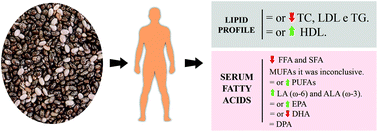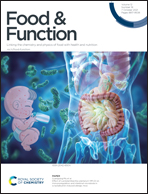Chia seed (Salvia hispanica L.) consumption and lipid profile: a systematic review and meta-analysis†
Abstract
Chia (Salvia hispanica L.) is an annual herbaceous plant, originally from southern Mexico and northern Guatemala – nowadays grown all over the world. In recent years, there has been an increase in demand for plant foods with health-promoting properties, and chia is a main actor in this process due to its high nutritional and functional value and its chemical composition rich in PUFAs, mainly ω-3, as well as protein, dietary fiber, and bioactive compounds. Chia has been explored in different research models for health and the prevention of human diseases. Evidence has suggested potential for improving insulin resistance, disordered lipid profiles, glucose tolerance and even adiposity. The aim of this study was to evaluate the effect of consumption of chia seeds on the lipid profile, triglycerides, and serum ω-3 fatty acids in adults. This systematic review included all randomized controlled trials (parallel or crossover design) published up to August 2020 in the main databases Medline, Embase, Scopus, Web of Science, and Scielo. Two independent authors selected and extracted data from those articles. After the selection process, 10 clinical trials were included. Forest plots and summary tables were constructed to present data and sensitivity subgroup analyses were performed for some of the outcomes. The results showed that chia consumption suggests a protective effect on the lipid profile, decreasing TC (MD = −2.98, 95% CI = [−9.98; 4.02]), TG (MD = −14.09 mg dL−1, 95% CI = [−33.46; 5.28]), and LDL (MD = 2.07 mg dL−1; 95% CI = [−5.05; 9.19]) and increasing HDL (MD = −2.92 mg dL−1, 95% CI = [−5.91; 0.06]). Regarding serum fatty acids, chia reduced FFA and SFA and increased PUFAs, ALA, EPA, and LA. It has also reduced DHA while not changing DPA. The intake of chia appears to have a neutral or beneficial effect on some markers of the lipid and fatty acid profile.



 Please wait while we load your content...
Please wait while we load your content...